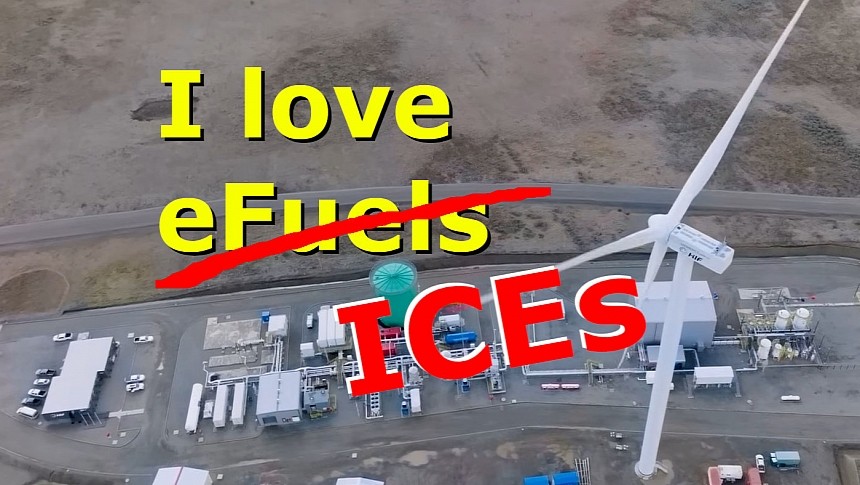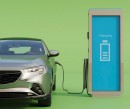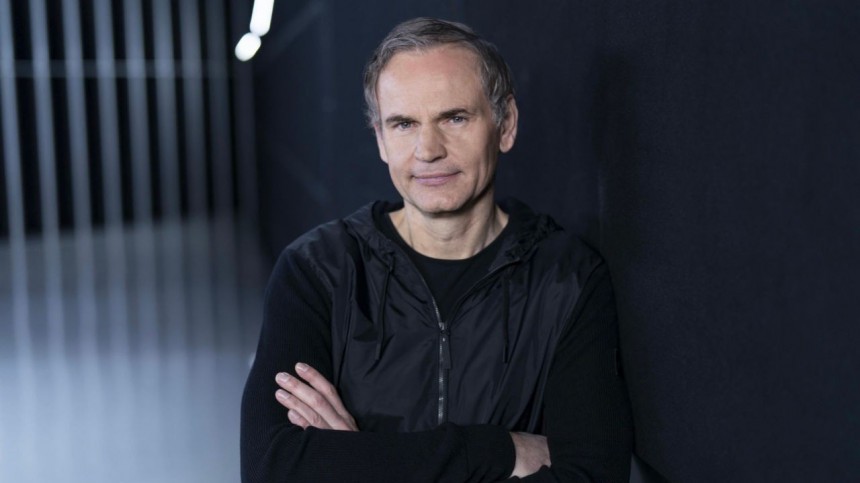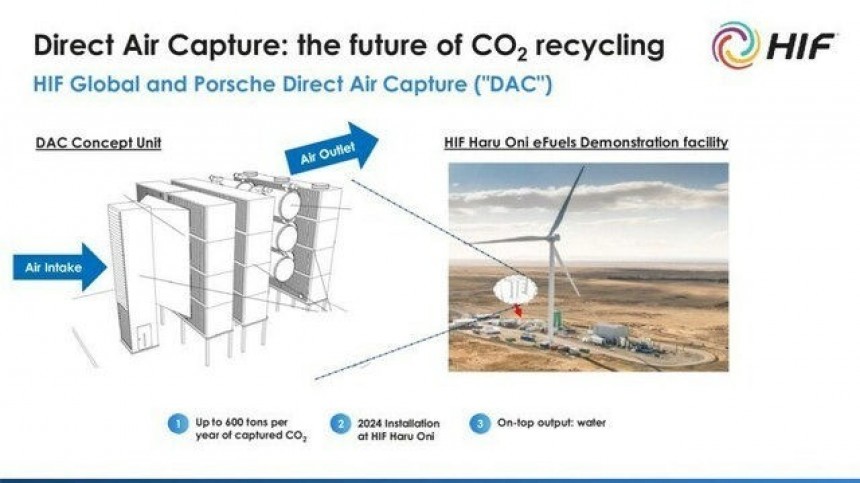IAA MOBILITY 2023 wasn't only about electromobility, as we've seen in previous parts of this material. On the three-day conference "E-Fuels – Paving the Way for Clean Mobility," BMW and Mercedes-Benz high-ranking officials came out to the ramp and expressed their confidence in the future of e-fuels.
To better understand the rally of the biggest German manufacturers around the e-fuels subject, let's take a look at recent developments. So, what have you been doing lately, Audi and Porsche, BMW and Mercedes-Benz?
But then the COVID-19 pandemic challenged the group's plans, and 2022 recorded the worst delivery numbers in a decade. It was the perfect pretext to replace the too-much-EV-oriented Herbert Diess CEO with Oliver Blume, Porsche's ex-CEO and a known performance ICEs advocate. Coincidentally, he greenlighted the e-fuel pilot project in Chile, now the spearhead for e-fuel propaganda.
He indeed stated that e-mobility would be superior to any form of ICE, and that's why VW Group is investing over $120 billion into electrification and digitalization until 2027 out of the $190 billion total investment budget. But he also stated that e-fuels were seen just as an adjacent and temporary solution for decarbonizing car markets outside Europe, in slow-developing countries in Asia, Africa, and South America.
In the beginning, BMW's approach to electrification was a cautious move: the i sub-brand was testing the waters, but it also helped the brand to offset performance engines' emissions. And it made a clear differentiation between the traditional public and EV enthusiasts. Today, BMW is still pursuing this strategy, but the core business remains the ICE division, which is strongly associated with the brand's sporty image.
Mercedes-Benz took another approach at first: converting regular cars into electric ones. It was the basis for the next paradigm: one platform should offer as many alternatives as possible, ranging from petrol and diesel engines to plug-in hybrids and electric and hydrogen propulsion. Today, they also have the EQ sub-brand, but, like BMW, ICEs are their focus.
Both companies faced similar problems because of COVID-19 supply chain bottlenecks, profit drops, and not-so-high interest in EVs. These luxury German brands are known for their high margins on expensive models, usually powered by big engines. It's different with costly electric models, where profits are much smaller. Besides, big displacements and heavy cars mean high levels of emissions and pollutants. So, stricter emissions standards endanger V6, V8, or V12 guzzlers.
Basically, all German luxury carmakers are ill-prepared for the shift to electromobility, even if they try to convince the public that this is the future they embrace. Well, it must be just a lucky coincidence that the German government forced the EU to make an exception regarding ICEs using e-fuels.
Now, VW, BMW, and Mercedes-Benz are "forced" in their turn to join the e-fuel bandwagon, which avoids killing the golden goose – big and profitable engines. I'm sure that Stellantis' example (described in the second part of this material), to voluntarily phase out ICEs from passenger cars sold in Europe by 2030, is considered a stupid an unfortunate business decision by German CEOs.
German luxury carmakers simply use the "putting all the eggs in one basket is not wise" proverb to justify the "necessary addition" syntagm used by Germany's Federal Minister for Digital and Transport regarding e-fuels. The only thing missing from the picture is the logic behind the decision not to phase out ICEs in Europe.
For decades, German carmakers invested in China and enjoyed big profits thanks to a low-cost working force, cheaper resources, and a booming car market. However, the Chinese government surprised everyone with its bold program to incentivize renewables and electromobility.
Soon after, several Chinese battery companies emerged as global players, while a flock of newborn electric carmakers flooded the market with cheap EVs. At first, they were laughable regarding built quality or battery performance. But, Chinese companies quickly adapted and improved their products. Today, China is the global leader in battery-electric vehicles.
The next step is Europe's "invasion" with more affordable EVs than European carmakers can put on the market. BYD, NIO, MG, or Xpeng have already set foot in Europe, and their EVs are, on average, around 20% more affordable than correspondent European EVs. The Chinese plan to sell at least one million cars per year in Europe by 2030, which will be almost 10% of European electric car sales.
So, the real problem for the European car industry is the EV sector, where China has the lead. No wonder that the talks around stricter Euro 7 emission standards led to accusations from carmakers that Bruxelles is opening wide Europe's gates to a "Chinese EVs invasion." Of course, the cure could be a higher import tariff for Chinese EVs, but there's a catch.
German carmakers fear retaliation from the Chinese government, which would hit German companies operating in China hard. So, they opposed to increasing import tariffs. On the other hand, German luxury carmakers are not too worried about the "Chinese EVs invasion" in Europe, as the Chinese target the affordable prices segment, not the premium ones.
In fact, Stellantis is the most exposed to a Chinese invasion, not Audi, Porsche, BMW or Mercedes-Benz. Volkswagen, Seat, and Skoda are not too worried, as VW Group recently took the industry by surprise, announcing it will use Chinese EV platforms for its future electric cars sold in China. But we can already predict those EVs will be sold worldwide, even in Europe at some point.
Basically, German carmakers know that the Chinese are one or two steps ahead regarding battery technology. But they also understand that no one can compete with performance engines developed by Porsche, Audi, BMW, and Mercedes-Benz. This is what German luxury carmakers are best at.
No wonder e-fuels suddenly became the perfect solution to save dinosaurs big and powerful ICEs from extinction. So, the e-fuels subject is more of a subterfuge to allow them to profit from big engines. It's interesting – or should I say outrageous? – how they used others' concerns to impose their request regarding engine manufacturing.
Then, researchers from the REF4FU project concluded that "only 60% of the fuel today is consumed by individual car traffic." Other applications would greatly benefit from the e-fuels until batteries, hydrogen, or other non-polluting solutions would be suitable for them.
In other words, we'll need e-fuels for several decades to gradually replace all fossil-fuel-based fuels until all ICEs are phased out. It's a solid business case, and I agree that governments should incentivize e-fuel production – but on one condition only: they should be a transitory solution, not an alternative for the future.
We should also consider that producing e-fuels requires much renewable energy. To some degree, this will delay decarbonizing the energy sector, which is accountable for most emissions today. Also, they are produced using captured CO2 from the atmosphere, but they put it back when they burn inside engines. To tackle global warming, we should use carbon capture technology to extract as much CO2 as possible from the atmosphere, not just "recycle" it.
It's the researchers' job to balance the pros and cons, but this is an argument for producing e-fuels only for a limited necessary time, not in the long run. E-fuels threaten the fossil fuel industry, while for the car industry, e-fuels save the day. But, in the end, e-fuels are the necessary evil we must live with for some time, not forever.
So, in my humble opinion – not as an electrohead, but as an inhabitant of Earth – there's no logical reason for the EU to allow carmakers to continue manufacturing internal combustion engines beyond 2035. Unfortunately, the decision was made in a harsh context, dominated by social and political threats.
This decision will delay the development and adoption of non-polluting cars in Europe and, most likely, worldwide. Of course, e-fuel engines will be less polluting than oil-based ones, but they will still threaten our health and environment.
Also, don't expect significant improvements in engine technology, as carmakers have accustomed us to small evolutions from one generation to another, not giant leaps. On the other hand, more technical complexity means lower reliability. This is not good news for users, but it's suitable for servicing cars and maintenance programs.
In the end, I'm afraid we'll all be the losers. Once again, the UN warned us that the window of opportunity to tackle global warming "is rapidly closing." The 2015 Paris Climate Agreement goals are now derailed. Still, I'm sure the COP28 climate summit in Dubai later this year will emphasize e-fuels' central role in transport decarbonization despite e-fuels being far from being a mature technology.
Pushing electrification collided with the business-as-usual paradigm
Volkswagen, currently the best-placed carmaker in Fortune's Global 500 ranking, had its ups and downs after the "Dieselgate" earthquake. The mandatory damage control communication strategy led to a significant shift toward electrification. Volkswagen Group even exposed its ambitions to overthrow Tesla.But then the COVID-19 pandemic challenged the group's plans, and 2022 recorded the worst delivery numbers in a decade. It was the perfect pretext to replace the too-much-EV-oriented Herbert Diess CEO with Oliver Blume, Porsche's ex-CEO and a known performance ICEs advocate. Coincidentally, he greenlighted the e-fuel pilot project in Chile, now the spearhead for e-fuel propaganda.
He indeed stated that e-mobility would be superior to any form of ICE, and that's why VW Group is investing over $120 billion into electrification and digitalization until 2027 out of the $190 billion total investment budget. But he also stated that e-fuels were seen just as an adjacent and temporary solution for decarbonizing car markets outside Europe, in slow-developing countries in Asia, Africa, and South America.
Mercedes-Benz took another approach at first: converting regular cars into electric ones. It was the basis for the next paradigm: one platform should offer as many alternatives as possible, ranging from petrol and diesel engines to plug-in hybrids and electric and hydrogen propulsion. Today, they also have the EQ sub-brand, but, like BMW, ICEs are their focus.
Both companies faced similar problems because of COVID-19 supply chain bottlenecks, profit drops, and not-so-high interest in EVs. These luxury German brands are known for their high margins on expensive models, usually powered by big engines. It's different with costly electric models, where profits are much smaller. Besides, big displacements and heavy cars mean high levels of emissions and pollutants. So, stricter emissions standards endanger V6, V8, or V12 guzzlers.
Basically, all German luxury carmakers are ill-prepared for the shift to electromobility, even if they try to convince the public that this is the future they embrace. Well, it must be just a lucky coincidence that the German government forced the EU to make an exception regarding ICEs using e-fuels.
Now, VW, BMW, and Mercedes-Benz are "forced" in their turn to join the e-fuel bandwagon, which avoids killing the golden goose – big and profitable engines. I'm sure that Stellantis' example (described in the second part of this material), to voluntarily phase out ICEs from passenger cars sold in Europe by 2030, is considered a stupid an unfortunate business decision by German CEOs.
German luxury carmakers simply use the "putting all the eggs in one basket is not wise" proverb to justify the "necessary addition" syntagm used by Germany's Federal Minister for Digital and Transport regarding e-fuels. The only thing missing from the picture is the logic behind the decision not to phase out ICEs in Europe.
China, are you the (electric) elephant in the (European) room?
In 2022, China overtook Germany and became the second-largest car exporter in the world. And in the first months of 2023, it seems that China also overtook the leader Japan. Of course, China benefits from the Russia-Ukraine war context – because of international sanctions, Russia imports cars only from China these days.For decades, German carmakers invested in China and enjoyed big profits thanks to a low-cost working force, cheaper resources, and a booming car market. However, the Chinese government surprised everyone with its bold program to incentivize renewables and electromobility.
Soon after, several Chinese battery companies emerged as global players, while a flock of newborn electric carmakers flooded the market with cheap EVs. At first, they were laughable regarding built quality or battery performance. But, Chinese companies quickly adapted and improved their products. Today, China is the global leader in battery-electric vehicles.
The next step is Europe's "invasion" with more affordable EVs than European carmakers can put on the market. BYD, NIO, MG, or Xpeng have already set foot in Europe, and their EVs are, on average, around 20% more affordable than correspondent European EVs. The Chinese plan to sell at least one million cars per year in Europe by 2030, which will be almost 10% of European electric car sales.
German carmakers fear retaliation from the Chinese government, which would hit German companies operating in China hard. So, they opposed to increasing import tariffs. On the other hand, German luxury carmakers are not too worried about the "Chinese EVs invasion" in Europe, as the Chinese target the affordable prices segment, not the premium ones.
In fact, Stellantis is the most exposed to a Chinese invasion, not Audi, Porsche, BMW or Mercedes-Benz. Volkswagen, Seat, and Skoda are not too worried, as VW Group recently took the industry by surprise, announcing it will use Chinese EV platforms for its future electric cars sold in China. But we can already predict those EVs will be sold worldwide, even in Europe at some point.
Basically, German carmakers know that the Chinese are one or two steps ahead regarding battery technology. But they also understand that no one can compete with performance engines developed by Porsche, Audi, BMW, and Mercedes-Benz. This is what German luxury carmakers are best at.
No wonder e-fuels suddenly became the perfect solution to save dinosaurs big and powerful ICEs from extinction. So, the e-fuels subject is more of a subterfuge to allow them to profit from big engines. It's interesting – or should I say outrageous? – how they used others' concerns to impose their request regarding engine manufacturing.
Relying on e-fuels for the long term is a mistake
We've seen that forecasts suggest ICE vehicles will still account for the large majority of the global fleet in 2050, especially in slow-developing countries in Asia, Africa, and South America. E-fuels seem like an optimal solution to slash emissions from ICE vehicles. Still, they should be perceived as a transition solution until all ICE vehicles are replaced by non-polluting cars.Then, researchers from the REF4FU project concluded that "only 60% of the fuel today is consumed by individual car traffic." Other applications would greatly benefit from the e-fuels until batteries, hydrogen, or other non-polluting solutions would be suitable for them.
In other words, we'll need e-fuels for several decades to gradually replace all fossil-fuel-based fuels until all ICEs are phased out. It's a solid business case, and I agree that governments should incentivize e-fuel production – but on one condition only: they should be a transitory solution, not an alternative for the future.
We should also consider that producing e-fuels requires much renewable energy. To some degree, this will delay decarbonizing the energy sector, which is accountable for most emissions today. Also, they are produced using captured CO2 from the atmosphere, but they put it back when they burn inside engines. To tackle global warming, we should use carbon capture technology to extract as much CO2 as possible from the atmosphere, not just "recycle" it.
So, in my humble opinion – not as an electrohead, but as an inhabitant of Earth – there's no logical reason for the EU to allow carmakers to continue manufacturing internal combustion engines beyond 2035. Unfortunately, the decision was made in a harsh context, dominated by social and political threats.
This decision will delay the development and adoption of non-polluting cars in Europe and, most likely, worldwide. Of course, e-fuel engines will be less polluting than oil-based ones, but they will still threaten our health and environment.
Also, don't expect significant improvements in engine technology, as carmakers have accustomed us to small evolutions from one generation to another, not giant leaps. On the other hand, more technical complexity means lower reliability. This is not good news for users, but it's suitable for servicing cars and maintenance programs.
In the end, I'm afraid we'll all be the losers. Once again, the UN warned us that the window of opportunity to tackle global warming "is rapidly closing." The 2015 Paris Climate Agreement goals are now derailed. Still, I'm sure the COP28 climate summit in Dubai later this year will emphasize e-fuels' central role in transport decarbonization despite e-fuels being far from being a mature technology.









